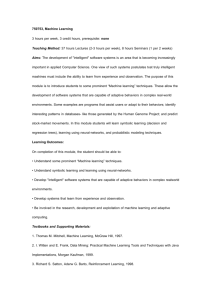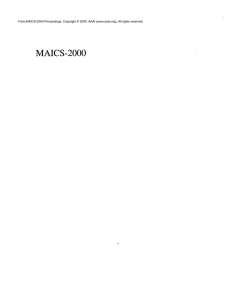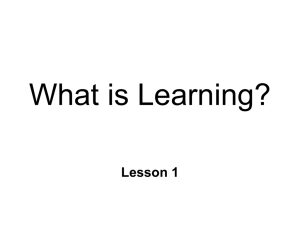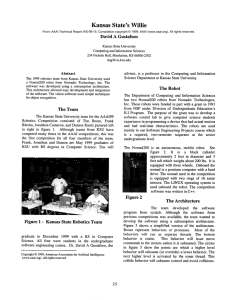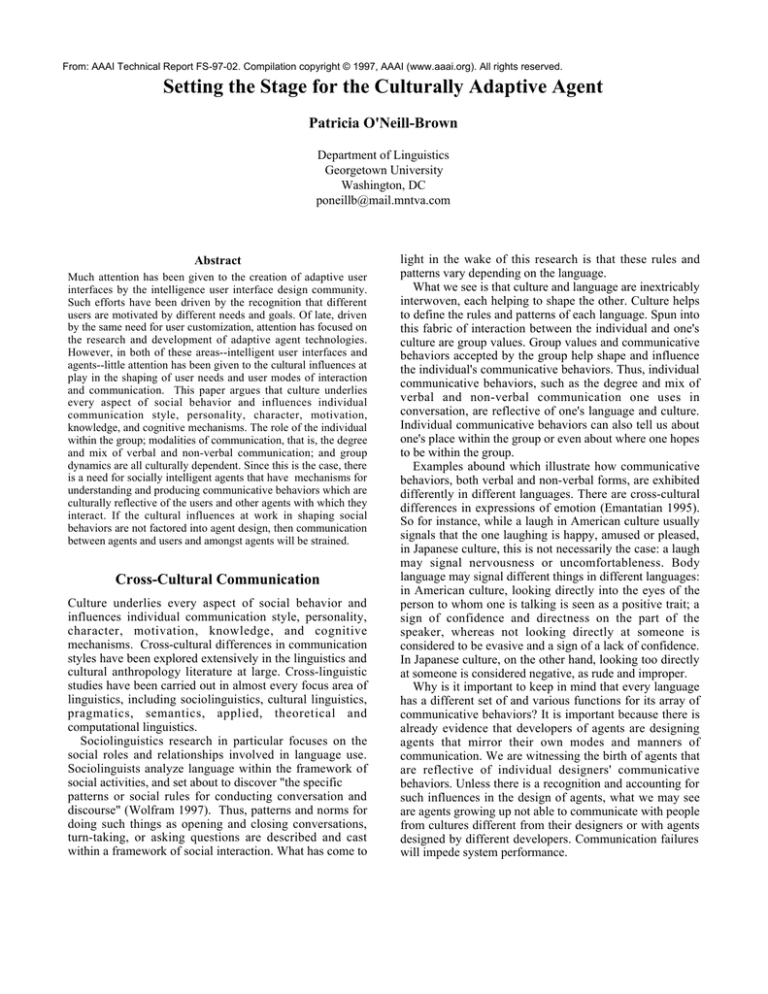
From: AAAI Technical Report FS-97-02. Compilation copyright © 1997, AAAI (www.aaai.org). All rights reserved.
Setting the Stage for the Culturally Adaptive Agent
Patricia O'Neill-Brown
Department of Linguistics
Georgetown University
Washington, DC
poneillb@mail.mntva.com
Abstract
Much attention has been given to the creation of adaptive user
interfaces by the intelligence user interface design community.
Such efforts have been driven by the recognition that different
users are motivated by different needs and goals. Of late, driven
by the same need for user customization, attention has focused on
the research and development of adaptive agent technologies.
However, in both of these areas--intelligent user interfaces and
agents--little attention has been given to the cultural influences at
play in the shaping of user needs and user modes of interaction
and communication. This paper argues that culture underlies
every aspect of social behavior and influences individual
communication style, personality, character, motivation,
knowledge, and cognitive mechanisms. The role of the individual
within the group; modalities of communication, that is, the degree
and mix of verbal and non-verbal communication; and group
dynamics are all culturally dependent. Since this is the case, there
is a need for socially intelligent agents that have mechanisms for
understanding and producing communicative behaviors which are
culturally reflective of the users and other agents with which they
interact. If the cultural influences at work in shaping social
behaviors are not factored into agent design, then communication
between agents and users and amongst agents will be strained.
Cross-Cultural Communication
Culture underlies every aspect of social behavior and
influences individual communication style, personality,
character, motivation, knowledge, and cognitive
mechanisms. Cross-cultural differences in communication
styles have been explored extensively in the linguistics and
cultural anthropology literature at large. Cross-linguistic
studies have been carried out in almost every focus area of
linguistics, including sociolinguistics, cultural linguistics,
pragmatics, semantics, applied, theoretical and
computational linguistics.
Sociolinguistics research in particular focuses on the
social roles and relationships involved in language use.
Sociolinguists analyze language within the framework of
social activities, and set about to discover "the specific
patterns or social rules for conducting conversation and
discourse" (Wolfram 1997). Thus, patterns and norms for
doing such things as opening and closing conversations,
turn-taking, or asking questions are described and cast
within a framework of social interaction. What has come to
light in the wake of this research is that these rules and
patterns vary depending on the language.
What we see is that culture and language are inextricably
interwoven, each helping to shape the other. Culture helps
to define the rules and patterns of each language. Spun into
this fabric of interaction between the individual and one's
culture are group values. Group values and communicative
behaviors accepted by the group help shape and influence
the individual's communicative behaviors. Thus, individual
communicative behaviors, such as the degree and mix of
verbal and non-verbal communication one uses in
conversation, are reflective of one's language and culture.
Individual communicative behaviors can also tell us about
one's place within the group or even about where one hopes
to be within the group.
Examples abound which illustrate how communicative
behaviors, both verbal and non-verbal forms, are exhibited
differently in different languages. There are cross-cultural
differences in expressions of emotion (Emantatian 1995).
So for instance, while a laugh in American culture usually
signals that the one laughing is happy, amused or pleased,
in Japanese culture, this is not necessarily the case: a laugh
may signal nervousness or uncomfortableness. Body
language may signal different things in different languages:
in American culture, looking directly into the eyes of the
person to whom one is talking is seen as a positive trait; a
sign of confidence and directness on the part of the
speaker, whereas not looking directly at someone is
considered to be evasive and a sign of a lack of confidence.
In Japanese culture, on the other hand, looking too directly
at someone is considered negative, as rude and improper.
Why is it important to keep in mind that every language
has a different set of and various functions for its array of
communicative behaviors? It is important because there is
already evidence that developers of agents are designing
agents that mirror their own modes and manners of
communication. We are witnessing the birth of agents that
are reflective of individual designers' communicative
behaviors. Unless there is a recognition and accounting for
such influences in the design of agents, what we may see
are agents growing up not able to communicate with people
from cultures different from their designers or with agents
designed by different developers. Communication failures
will impede system performance.
Agents as Mirror Images of Their Developers
There are indications that not only embodied agents in
concrete, dynamic environments carry cultural
configurations, but the wide array of computational
processes. It appears that whether the agent characters are
implemented as data structures and computational
processes or as robots, cultural influences are at work in the
developer's design process (O'Neill-Brown 1997). An
example of cultural influences at work in the developer's
design process can be seen in some of the current work in
the development of socially intelligent agents. For the
purpose of developing a service agent, developers at Sony
Computer Science Laboratory are attempting to account for
the totality of the speech act, including verbal and nonverbal (body language) behaviors as well as situational
context (Nagao and Rekimoto 1996). Presumably, the
service agent, The Ubiquitous Talker, which recognizes
and produces spoken language, is programmed to
communicate only in Japanese. The developers report that
they are taking into account prosody and gestural
information (Nagao and Rekimoto 1995). However, it is
not clear whether the developers are considering having the
service agent communicate in languages other than
Japanese.
If they are, they must keep in mind that if they wish to
design an application that can be used effectively by
speakers of languages other than Japanese, they will need
to take into account the fact that prosodic features of
languages and gestures, such as nods and gazes, vary
according to language and culture. Such behaviors may
vary in terms of amount, duration, and timing. In addition,
the meaning ascribed to gestures and other non-verbal
forms of communication also varies according to the
language and culture. For instance, when a native speaker
of English who is American asks the question, "who, me?,"
he may point to himself, and if she does, it is usually at the
upper chest area. However, when a native speaker of
Japanese asks the same question, he points to his nose.
It was asked in the Call for Papers for this symposium as
to what degree do artificial agents which communicate with
humans have to be human-like (e.g. possess a human-face,
mimic human speech or gestures and so on) to be socially
acceptable to human societies. It was also asked what, if
anything, will be lost by excluding such human physical
characteristics. The answer to these questions depend in
part on the culture that the end user comes from. It may be
the case that some users will desire anthropomorphic
agents and some will not, and such preferences may have a
cultural basis. Some anecdotal evidence from the U.S.
market suggests that U.S. users do not tend to favor
anthropomorphic agents while Japanese users prefer them.
Microsoft's "Bob," for instance, did not stimulate too
much interest in the U.S. marketplace. In addition, one
often hears U.S. users remarking that they do not favor
acting in intimate ways with machines, such as ATM
machines. Similarly, of note is that the preponderance of
those leaders in the field of Human Computer Interaction
voicing their opinion at the Intelligent User Interface 97
Conference that anthropomorphic agents were not
necessary or desirable and can even, in some cases, be an
intrusion or a detriment to a user completing a task,
happened to be Americans who were native speakers of
English.
Japanese users, on the other hand, seem to openly
embrace human-like agents. Strong research and
development directions are being taken by the Japanese to
develop adaptive agent systems, and many of these have an
anthropomorphic look and feel if not "face." In a
benchmarking study on human-computer interaction
technologies in Japan, the study team reports:
The fundamental idea behind the work we observed is
to make computers behave as humans would, obeying
social rules and communicating with emotional
feedback (Holdridge 45:1996).
The JTEC panel cites the research being carried out at the
Japan-based Sony Computer Science Laboratory, Inc.,
which is focused on how facial expressions, voice tones
and gestures communicate human feelings to illustrate
efforts towards the goal of introducing emotion into
human-computer interactions. Sony researchers have
found through testing with users, that facial expressions are
helpful; they note, especially "upon first contact with the
system" (Nagao and Takeuchi 1994).
Similarly, researchers at the Image and Media
Laboratories at Sharp Corporation developed an agent
which gauges the nodding and gazing behaviors of the
human it is interacting with and responds appropriately
with its own nodding and gazing responses (Sakamoto
1997). In order to develop such an agent, Sharp researchers
studied Japanese subjects engaged in conversation in order
to characterize nodding behaviors and gaze direction. They
then programmed a knowledge of such behaviors into the
agent which included how to detect and respond to them.
An agent was built for the purposes of helping the user
select a television station. An experiment was then set up in
which the subjects switched from having the agent
response mode turned on to having it turned off. After
testing, surveys taken to assess user preferences revealed
that they preferred the response feature.
Detecting and Responding to Different Forms
of Social Interaction
As agents are being built to interact with humans and with
other agents in multiagent heterogeneous systems, it will be
critical to code into these agents built-in features for a)
detecting different forms of communicative behaviors and
b) responding to them appropriately. Such a feature will be
necessary to build into any agent, whether it be a robot or
some sort of computational process such as a software
agent, if this agent is to be able to interact with agents in
heterogeneous environments and a host of individuals from
a wide variety of backgrounds.
Human beings are able to bridge cross-cultural
differences in communication behaviors and styles by
being able to a) detect such differences and b) respond
appropriately. The ability to detect differences and respond
appropriately to achieve successful communication can be
learned explicitly. We do this when we learn second
languages. Indeed, as any second language learner can
attest to, it is vital to simulate the behaviors exhibited by
native speakers of the target language if one is to
effectively communicate with the speakers of that
language.
There is a precedent for the development of adaptive
systems in the intelligence user interface design
community. If we look at the directions in interface
development over the last decade or so in the Human
Computer Interaction (HCI), Intelligent User Interface
(IUI) and Arificial Intelligence (AI) communities, we see
much attention being given to user adaptivity issues at the
interface level. Users are not viewed as "cookie cutter cutouts," but rather, as individuals with different desires, goals
and needs. Thus, there has been a good deal of research
and development activity in interfaces that are
automatically adaptive to individual users or can be
customized by users themselves depending upon their
individual preferences, needs and goals. For a sampling of
such work, see Greenberg and Witten 1984; Kuhme et.al.
1992; Kuhme 1993; Thomas 1993; Piyawadee 1993; Maes
1994; Thomas and Krogsaeter 1993; Benyon and Murray
1993. See also project descriptions of The HumanComputer Interaction Laboratory at the University of
Maryland, now in its fourteenth year of operation, which
has been at the forefront in the development of adaptive
user interfaces. See program description and list of projects
at http://www.cs.umd.edu/ projects/hcil/index.html.
Spinning off from the work that has been carried out in
intelligent user interface development are current efforts
that are being focused towards the development of adaptive
agents in multiagent and human-agent systems. The 1997
International Conference on Intelligent User Interfaces
devoted a portion of the program to a discussion of
adaptive agents; see Kerpedjiev et. al 1997; McCoy et.al
1997; and Schlungbaum 1997. Likewise, the American
Association for Artificial Intelligence (AAAI) has
increasingly been holding symposia and workshops on
adaptive agents; see Sandip 1996, Milind
and
Gmytrasiewicz 1996, and Ibrahim 1996.
While such efforts at developing adaptive interfaces and
agents exist, very little attention has been given to the
cultural influences at work in the shaping of user needs and
user modes of interaction and communication. However,
since there are already existing approaches geared to
capturing and developing systems which are adaptable to
and by users, it would not be a stretch for developers to
fold in a mechanism to account for the cultural differences
of users.
The Culturally Adaptive Agent in Action
It is easy to see the need for service agents to have a
mechanism for detecting and producing culturally
acceptable forms of communication in order to help
effectively meet the needs of the user that it is servicing.
The issue of service agents makes me think of the
discussion I engendered after delivering my paper at the
AAAI Spring Symposium on Computational Models for
Mixed Initiative Interaction. In my presentation, I
discussed the ways in which cultural influences are already
playing a major role in the design of software and hardware
agents, in both natural and synthetic environments,
providing evidence of this through comparative analysis of
the behavior of agents developed by Japanese versus U.S.
developers. One of the participants in the symposium, a
German woman, about twenty-nine years of age who was
in the United States for the first time, agreed that cultural
influences factor very much into our interactions with
people.
She pointed out an instance in which she had recently
been at a restaurant in the U.S. and the waiter started to
initiate casual conversation with her. She commented that
she had a funny reaction to his behavior since to her, a
waiter is a waiter, he's there to serve and not to speak to
you as if he was your friend. This impression was
confirmed by the organizer of this symposium, a German
woman as well. Based on input such as this, one might
begin to consider whether a service robot designed to
interact with people from Germany ought to be designed to
act differently from a service robot geared to Americans,
for example, in order to maximize effective
communications, and thus, user satisfaction. After all,
expectations about service and the communications by
which it is facilitated, are, in part, informed by culture.
Tutoring agents will also have to be culturally
adaptive if they are to be effective instructors. I n
Microsoft's package TutorAssist, aimed at helping children
to develop basic skills which will be introduced into the
marketplace in September, is an animated character,
Professor P.T. Presto, which will recognize when students
require help. It will be interesting to find out what this
character looks like and how it interacts with children in
order to see whether this character can work effectively
with children speaking different languages and coming
from different cultures. Since pedagogical approaches and
attitudes, expectations about the student-teacher
relationship, and the mode and manner of student and
teacher interactions all vary according to culture, it will be
interesting to see if Professor Presto will turn out to be a
one-size-fits-all kind of teacher. Perhaps Professor Presto's
teaching style will have to be modified depending on the
varying needs of his or her students. Perhaps Professor
Presto may have to undergo a name change, as the word
"presto" suggests that learning is to take place as if by
magic, a belief to which every culture may not ascribe.
In addition to cultural influences at work in agent design,
it appears that male-female differences are also playing a
role in determining "the look and feel" of the agents that
are springing to life. Nagao and Rekimoto's personal
shopper agent seems to be reflective of male shopping
behaviors (Nagao and Rekimoto 1996). Judging from the
features described, it seems as if the reason for having the
agent is to help expedite the shopping exercise; in other
words, to help the shopper get out of the store more
quickly. This approach to the shopping exercise is very
"male"--at least typical American males prefer to get in and
out of a store as quickly as possible. Generalizing about
American male versus female shopping behaviors, males
seem to be very goal-directed in their approach, whereas
females tend to view shopping as an experience, preferring
to "browse before the kill." Perhaps Japanese males and
females exhibit these same differences. If so, perhaps
females may prefer a feature that would help them to
browse more effectively as opposed to getting out of the
store more quickly.
In sum, if we are to develop socially intelligent agents
that have mechanisms for understanding and producing
communicative behaviors which are culturally reflective of
the users and other agents with which they interact, then
communication between agent and users and amongst
agents will be improved. Agents that are able to
communicate effectively in multiagent systems will result
in improved system performance. Improved
communication between socially intelligent agents and
humans will help to create satisfied "customers," and in
turn, help to expand the market base for these agents.
References
Basso, Keith. 1990. Western Apache Language and
Culture. Tucson: Univ. of Arizona.
Benyon, David and Dianne Murray. 1993. Developing
Adaptive Systems to Fit Individual Aptitudes. In
Proceedings of the 1993 International Workshop on
Intelligent User Interfaces, 115-121.
Casson, Ronald W. 1981. Language, Culture and
Cognition: Anthropological Perspectives. New York:
Macmillan.
Emantatian, Michele. 1995. Metaphor and the Expression
of Emotion: The Value of Cross-Cultural Perspectives.
Metaphor and Symbolic Activity, 10(3):163-182.
Greenberg, Saul and Ian H. Witten. 1984. Adaptive
Personalized Interfaces - A Question of Viability
Behaviour and Information Technology, 4(1): 31-35.
Holdridge, Geoffrey M., ed. 1996. JTEC (Japan Technical
Evaluation Center) Panel Report on Human-Computer
Interaction Technologies in Japan. Baltimore: International
Technology Research Institute.
Imam, Ibrahim F., Chair. 1996. Intelligent Adaptive
Agents. In Papers from the 1996 AAAI Workshop
Technical Report WS-96-04.
http://www.aaai.org/TechReports/Contents/Workshops/WS
-96-04.html.
Kerpedjiev, Stephan and Giuseppe Carenini, Steven Roth,
and Johanna Moore. 1997. Task-based Approach to
Multimedia Presentation. In Proceedings of the 1997
International Conference on Intelligent User Interfaces.
Kuhme, Thomas. 1993. A User-Centered Approach to
Adaptive Interfaces.
Knowledge-Based Systems, 6(4):239-248.
Kuhme, Thomas, and H. Dieterich, U. Malinowski, and M.
Schneider-Hufschmidt. 1992. Approaches to Adaptivity in
User Interface Technology.
In Proceedings of the IFIP {WG2.7} Working Conference
on Engineering for Human-Computer Interaction.
McCoy, Kathleen F. and Patrick Demasco, Christopher
Pennington and Arlene L. Badman. 1997. Some Interface
Issues in Developing Intelligent Communication Aids for
People with Disabilities. In Proceedings of the 1997
International Conference on Intelligent User Interfaces.
Maes, Pattie. 1994a. Social Interface Agents: Acquiring
Competence by Learning from Users and other Agents. In
Software Agents, Papers from the AAAI 1994 Spring
Symposium Technical Report SS-94-03, 71-78.
http://www.aaai.org/TechReports/Contents/Symposia/Sprin
g/SS-94-03.html.
Maes, Pattie. 1994b. Learning Interface Agents. In
Proceedings of the 1994 Friend21 International Symposium
on Next Generation Human Interface.
Nagao, Katashi and Akikazu Takeuchi. 1994. Speech
Dialogue with Facial Displays: Multimodal HumanComputer Conversation. In Proceedings of the 32nd
Annual Meeting of the Association for Computational
Linguistics (ACL-94), 102-109.
Nagao, Katashi and Jun Rekimoto. 1996. Agent
Augmented Reality: A Software Agent Meets the Real
World. In Proceedings of the Second International
Conference on Multiagent Systems (ICMAS-96).
http://www.csl.sony.co.jp/person/nagao.j.html.
Nagao, Katashi and Jun Rekimoto. 1995. Ubiquitous
Talker: Spoken Language Interaction with Real World
Objects. In Proceedings of the 14th International Joint
Conference on Artificial Intelligence (IJCAI-95), 2,:12841290.
O'Neill-Brown, Patricia. 1997. The Need for Culturally
Adaptive Agent Behavior. Presented at the American
Association for Artificial Intelligence Spring Symposium
Series Computational Models for Mixed Initiative
Interaction. http://www.mntva.com/pobtest/pob.ps.gz.
Palmer, Gary B. 1996. Toward a Theory of Cultural
Linguistics. Austin: University of Texas.
Schlungbaum, Egbert. 1997. Individual User Interfaces and
Model Based User Interface Software Tools. Poster
Session, 1997 International Conference on Intelligent User
Interfaces.
http://smi.stanford.edu/projects/mecano/iui97/ap.htm.
Sen, Sandip, Chair. 1996. Adaptation, Coevolution and
Learning in Multiagent Systems. In Papers from the 1996
AAAI Spring Symposium
Technical Report SS-96-0.
http://www.aaai.org/TechReports/Contents/Symposia/Sprin
g/SS-96-01.html.
Sukaviriya, Piyawadee. 1993. From user interface design to
the support of intelligent and adaptive interfaces: an
overhaul of user interface software infrastructure.
Knowledge-Based Systems, 6(4):220-229.
Tambe, Milind and Piotr Gmytrasiewicz, Cochairs. 1996.
Agent Modeling.
In Papers from the 1996 AAAI Workshop Technical
Report WS-96-02.
http://www.aaai.org/TechReports/Contents/Workshops/WS
-96-02.html.
Thomas, Christoph G. 1993. Design Implementation and
Evaluation of an Adaptive User Interface. KnowledgeBased Systems, 6(4):230-238.
Thomas, Christoph G. and Mete Krogsaeter. 1993. An
Adaptive Environment for the User Interface of Excel. In
Proceedings of the 1993 International Workshop on
Intelligent User Interfaces, 123-130.
Wolfram, Walt. 1997. Sociolinguistics: Language as Social
Behavior. http://www.lsadc.org/Wolfram.html. In The
Field of Linguistics, the Linguistic Society of America,
http://www.lsadc.org/flxtitlepg.html.
Wolk, Martin. 1997. Microsoft to Launch Line of
Education Software,
http://www.yahoo.com/headlines/970818/tech/stories/educ
ation_1.html.

